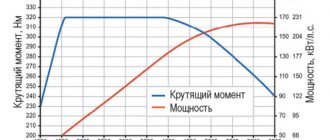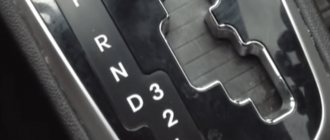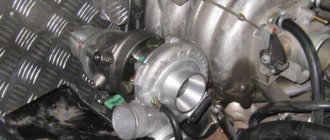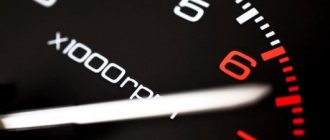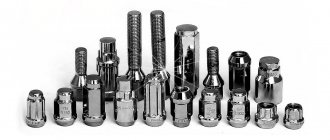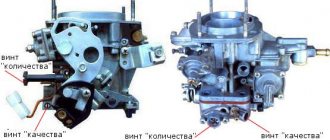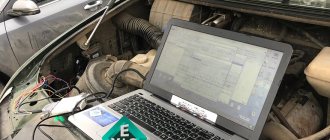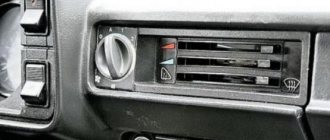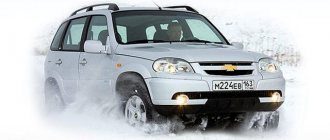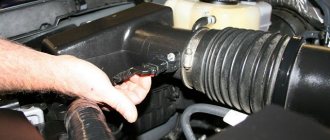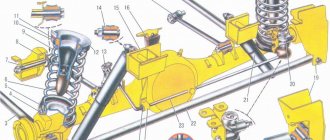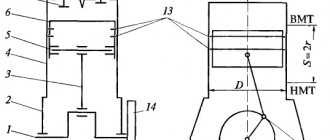- home
- Engine
- …
I know that many people are tormented by this question, many do not even understand the difference between torque and engine power. But really, which one is more important? We are used to choosing a car based on horsepower, but the torque is somehow undeservedly reduced! I personally talked to my friends, many of them don’t even know what kind of engine it is on their car and at what speed it is at its maximum! Is it correct? Of course not, you need to know and understand exactly all the technical characteristics of your car, especially such important ones. That’s why I decided to write this article and explain everything in simple words, as usual there will be a video version at the end...
Well, I’ll try to tell you in simple words, as best I can, but the topic is not as simple as it seems at first glance, there are descriptions on the Internet, but they are extremely confusing. In this article I will operate with such concepts as engine power and torque. In fact, these two designations go “side by side” and one characteristic directly depends on the other.
Engine power
It is measured in “Horsepower (hp)” or Kilowatts (Watts, “W”), as it becomes clear - it was carried out by James Watt. Yes, it is in Watts that we measure the power of incandescent light bulbs in our “chandeliers” and lamps, but it turns out that the power of the engine is also the same. I won’t go into details about how and what he discovered, it’s just that the description comes from his last name. BUT what about horsepower? And everything is simple, Watt “trained” on horses, namely on carried loads, with one horse per unit of time and at a certain distance, and so after certain “torment” it turned out that one horse (if it is forced to generate an electric current from a dynamo) capable of delivering 736 watts per second of time, or 75 kgf m/s, which can be deciphered as follows - 75 kilograms, per 1 meter of height, in 1 second of time. To convert “watts” to “horsepower”, there is a fairly large calculation, but if you exaggerate, you get 1kW=1000W=1.36hp.
Not all manufacturers indicate engine power in “hp”; for example, some German manufacturers indicate it in Watts.
In order to translate "L.S." in “Watts”, you need to divide them by 1.36. If you need the opposite, then multiply the power in “W” by 1.36, we get “horsepower”.
I think this is understandable, we will not return to this again.
The power of an internal combustion engine (be it gasoline or diesel ) is not a constant value! YOU NEED TO UNDERSTAND THIS! I’m simply touched by how many people react to this value: “I have 150 hp, I’ll make you look like two fingers,” and my opponent has 145 hp. and in theory it should lose, but it doesn't take into account the torque and distance over which the cars will compete.
Power varies depending on engine speed! Your nominal value will be indicated at certain MAXIMUM revolutions, for modern cars, usually from 5000 to 6500 revolutions. That is, in simple words, 150 hp. – issued at 6000 rpm (for example). Accordingly, at 3000 or 1500 rpm, the power will decrease significantly.
The power of an internal combustion engine, which is indicated in your technical specifications, is usually delivered at maximum engine speed. At 1500 - 2000 rpm, it will be 4 - 5 times less (true for gasoline units).
That is, in order to get the entire “herd” of the power unit, you need to actively “pedal”. For example, when overtaking or sharp maneuvers, you should keep almost your “shelf” at 5000 - 6500 revolutions, these are the revolutions that will help you accelerate sharply. That's why you often have to downshift in order to get maximum power.
BUT the power unit cannot spin up instantly, it needs time, and this is where the concept of torque comes in.
How is horsepower calculated?
Horsepower is a conventional and ambiguous unit of measurement of power.
In Russia and almost all European countries, horsepower is defined as 75 kg*m/s (metric horsepower), that is, as the power sufficient to lift a load weighing 75 kg to a height of 1 meter in 1 second. In this case, 1 liter. With. is exactly 735.49875 watts.
The maximum power that a horse can develop is usually called boiler horsepower. You can easily calculate your maximum power. To do this, you need to measure the time t during which you run up the stairs of height h and substitute it into the formula: m*h/t, where m is the mass of your body.
To determine engine power, special stands are used, more about this is written below.
Engine torque
It is worth understanding that motor power is the energy generated by the engine. And it is this energy that is converted into torque on the output (crank) shaft of the engine, then the torque is changed in the transmission (using the required gear ratios) and then transmitted to the drives, or drive axles, and then to the wheels.
That is, if we exaggerate, torque is actually what pushes the car mechanically, and power is what produces this moment.
You can get underway and drive even with a low-power engine (and for this we don’t need a lot of power), the gear ratios that are precisely selected in the transmission of your car work here.
BUT we don’t want to drive at a speed of 20 – 40 km/h, we need acceleration, fast movement. And for this you simply need sufficient torque at all speed ranges. This is achieved by sufficient engine power and the selection of gears in the transmission and drives, axles (if any).
If we derive the definition:
Torque is a force that is multiplied by the leverage of its application, which a motor can provide to a machine to overcome certain movement resistances. Measurements are made in newtons, and the lever is measured in meters.
If you break it down, simply “on your fingers the formula”, then 1 Nm is the force with which 0.1 kg presses on the end of a lever (this is a piston) 1 meter long. As it becomes clear, in the engine the role of a lever is played by the crankshaft crank, through which torque is produced. It is clear that the crank is not 1 meter long, but the moment is calculated from the attached characteristics.
It is on this indicator that the time it takes for the power unit to reach maximum power, and therefore the acceleration dynamics of the car, depends.
If we exaggerate figuratively, then the moment collects all the horsepower into a “fist” which spins the engine, and the larger this fist, the faster the engine spins and the car accelerates.
Calculation of power by engine volume
The attentive reader will probably have noticed that the first formula can be replaced directly with the second to simplify the calculations. The force in this case can be expressed as follows:
M = (KM x OD)/9549 = (O x L x OD)/(9549 x 0.0126) = (O x L x OD)/120.3.
The interpretation of this formula will be standard:
- O – engine volume.
- E – pressure in the combustion chamber.
- OD – revolutions.
- 120.3 is the new correction factor.
Note that the combustion chamber pressure (variable D) in the case of a standard gasoline engine is usually between 0.8-0.85 MPa . In the case of a modernized engine, this figure will be 0.9 MPa in the case of a diesel engine. 1-2 MPa .
Engine speed
Also an important indicator for various engine types. After all, the maximum torque can be generated at different speeds of the power unit. As I wrote above, on gasoline it can be 5000 or 6000! Therefore, in order to reach such an indicator, the motor needs to spend a certain time.
Of course, it’s better when the engine develops maximum torque, say at 1500 - 2000 rpm, then the time to spin up the power unit is several times less, and the car picks up speed faster.
Then it turns out that the main thing is not only in the magnitude of the moment, but also in the speed at which it is achieved. The smaller they are, the better.
And here a dilemma arises - which engines really have a large torque reserve?
Various types of engines
As we have understood, the lower the maximum torque occurs at lower speeds, the better, but what engines can be suitable for this? And in general, which ones have a “large supply” of this moment? After all, an ordinary naturally aspirated four-cylinder gasoline engine reaches its nominal value at approximately 5000 - 6000 rpm.
BUT there are motors that produce fairly large torques, and they occur at fairly low speeds. These are multi-cylinder engines, as well as “V”-shaped types, starting from V6 - V8. Turbocharged units have a large torque reserve, even with relatively small volumes.
However, the absolute record holder is the diesel variants, especially those that were installed on tractors, because traction at the bottom is important here (speed on highways is absolutely not needed). Such options reach their nominal value already at 1500 rpm, just imagine! Such units are called “high-torque” due to the rapid increase in torque.
Conventionally, motors can be divided into four camps:
- These are ordinary aspirated engines, 4 cylinders.
- Multi-cylinder units, from 6 to 12 “pots”; V-shaped ones can also be written here.
- These are turbocharged engines
- Diesel units
I won’t talk too much about “multi-cylinder” (the second type), here it is clear that the more cylinders, the greater the power and, accordingly, the torque. The only downside is that these units are heavy, power hungry, and very large in size.
But the other three types are worth comparing for a complete understanding, let’s take three engines from the new KIA SPORTAGE, look at the table.
| Engine capacity | Revolutions per minute (rpm) | Maximum power (in hp) | Torque (in Nm) |
| Gasoline, 4-cylinder in-line | 2.0 liters | 6200 | 150 |
| 4000 | 192 | ||
| Turbocharged, 4-cylinder in-line | 1.6 liters | 5500 | 177 |
| 2000 — 4500 | 265 | ||
| Diesel, 4-cylinder in-line | 2.0 liters | 4000 | 185 |
| 1750 — 2750 | 400 |
The petrol engine develops maximum power only at 6200 rpm, but maximum torque occurs already at 4000 rpm. Turbo option, 177 hp at 5500 rpm, but the torque here is much higher than 265 in the range from 2000 to 4500 rpm. But the record holder for hp. and the torque comes from a diesel engine, 185 hp. at 4000 rpm, and torque 400! (just think about it) in the range of 1750 - 2750 rpm.
As you can see, gasoline units are inferior to diesel engines in terms of torque (a regular aspirated engine is about 2 times less). Moreover, maximum performance can be achieved only at 4000 rpm. But the gasoline engine easily spins up to 6200, or even more than 7000 - 8500 rpm, which will allow it to develop more power. Diesels, on the other hand, cannot boast of high speeds; the maximum speed is often only 4000 - 5000 rpm, so they can lose in maximum power to their gasoline counterparts.
To put it simply, we can state that power determines the maximum speed of the car, but torque determines how quickly the unit reaches this power. Actually, everything is simple. BUT if you remember the laws of mechanics, then it’s worth remembering that while we gain in torque, we lose in rotational speed.
AT the start, a gasoline engine will win over a diesel unit! Why? YES, everything is simple, the gasoline unit can be turned up to 6500, and in rare cases up to 8000 rpm, without changing gears. But a diesel engine will reach its peak torque as quickly as possible (already at 1750 rpm) and you will need to spend time shifting, then another gear, etc. Of course, this situation is true for mechanics; on many modern automatic transmissions, switching occurs as quickly as possible. YES, and in order to compete with diesel, gasoline will always need to keep higher speeds in order to equal the power. For example, at 90 km/h on the highway, in order to accelerate on a gasoline unit, you need to shift the gear down (by increasing the speed, we increase the power), but a diesel engine does not need to do this!
Work and power
If we're talking about rotation, power is expressed as torque (T) multiplied by speed (w).
The rotational speed of an object is determined by measuring the time it takes for a certain point on a rotating object to complete a full rotation. Typically this value is expressed in revolutions per minute, i.e. min-1 or rpm. For example, if an object makes 10 complete revolutions per minute, that means its rotation speed is: 10 min-1 or 10 rpm.
So, rotation speed is measured in revolutions per minute, i.e. min-1.
Let's bring the units of measurement to a general form.
For clarity, let's take different electric motors to analyze in more detail the relationship between power, torque and speed. Although the torque and speed of electric motors vary greatly, they can have the same power.
For example, let's say we have a 2-pole motor (3000 rpm) and a 4-pole motor (1500 rpm). The power of both electric motors is 3.0 kW, but their torques are different.
Thus, the torque of a 4-pole electric motor is twice the torque of a two-pole electric motor with the same power.
How are torque and speed generated?
Now that we've covered the basics of torque and speed, we need to look at how they are created.
In AC motors, torque and speed are created by the interaction between the rotor and the rotating magnetic field. The magnetic field around the rotor windings will tend to the magnetic field of the stator. In real operating conditions, the rotor speed always lags behind the magnetic field. Thus, the magnetic field of the rotor crosses the magnetic field of the stator and lags behind it and creates a torque. The difference in the rotational speed of the rotor and stator, which is measured in %, is called the sliding speed.
Slip is the main parameter of an electric motor, characterizing its operating mode and load. The greater the load the electric motor must handle, the greater the slip.
Keeping in mind what was said above, let’s look at a few more formulas. The torque of an induction motor depends on the strength of the magnetic fields of the rotor and stator, as well as on the phase relationship between these fields. This relationship is shown in the following formula:
So what is more important and better?
Here it is difficult to say one comes out of the other. On the one hand, torque will allow you to quickly develop maximum power, in the example with a diesel engine, but it will not be able to spin up to the same speed as gasoline, which means its maximum power at peak will be lower. Here you know who needs what, maybe you are a commercial vehicle driver, and you don’t need maximum speed, but traction from the bottom is important. Or, on the contrary, you love turbo engines that spin up to 8000 - 9000 rpm and shoot off from a standstill.
Personally, I like new gasoline units, such as, say, Mazda’s Skyactiv engine, which is now installed on many models. Here they increased the compression ratio, brought the engine a little closer to a diesel engine, but it remained gasoline with high speeds. There is both power and torque, the golden mean! I think such engines are the future (if you don’t take hybrids and electric cars).
And remember: torque pushes the car forward, but power is what this moment produces. So we buy horsepower, and drive on torque!
Now let's watch the video version of the article.
And now vote on what you think is more important - torque or engine power.
I’ll finish here, read our AUTOBLOG, subscribe to the YOUTUBE channel.
Similar news
- Engine flushing oil. How to choose and whether you need it or...
- Turbine or compressor, which is better? And what is the difference between them? Etc…
- The oil pressure light stays on for a long time when starting. Especially in the cold...
